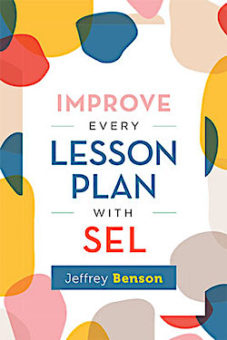A Game Plan to Include SEL in Every Lesson
Improve Every Lesson Plan with SEL
By Jeffrey Benson
(ASCD, 2021 – Learn more)

Unless you have been under a rock or on a space journey for the past few years, you know that social-emotional learning (SEL) is a hot topic in education, and concern for our students and schools has only increased in the last year due to COVID-19 and race/equity issues.
SEL has been the subject of many advisory programs, literature books, and specialized curricula, but it’s often addressed from a stand-alone, siloed approach. A book about how to make SEL accessible in every classroom and every lesson is a new, much needed perspective.

The book is refreshing and helpful because it outlines how to naturally incorporate SEL skills as an embedded part of the teacher’s daily lesson plan, from planning to closure.
Each chapter of the book includes examples broken down by elementary, middle and secondary development; action steps to aid in immediate implementation; and questions and answers to help teachers troubleshoot before problems arise, including addressing issues related to remote learning, racism, and equity.
The Essential SEL Skills
The cornerstone of the book is the identification and discussion of the Essential SEL Skills (Skills for Self, Interpersonal Skills, and Skills as a Community Member). These are the skills that most teachers already ask students to demonstrate, but Benson suggests that identifying an explicit SEL objective alongside the content objective will help move students from passive compliance to active engagement.
Clear objectives alert students to the intended goals and engage students in both explicit and implicit understandings. This helps the students grasp the “why” behind the skill and lesson (especially because the teacher is now “selling” the SEL skill alongside the content objective).
With a firm grasp on expected SEL goals, teachers can use the praise, explicit and implicit strategies, turn-and-talks, and goal setting outlined in the book to embed SEL skills seamlessly into the objectives and daily classroom routine.
Gaining Student Engagement
Once the goals are set, there is still work to be done before teaching begins. The teacher must gain the interest and motivation of the students. Benson offers three high-yield activities teachers can use (without much additional effort) to promote SEL skills as students enter the classroom: greeting students, settling activities, and ”do-now” activities.
- Greeting students at the door builds a positive culture that supports good SEL skills, builds relationships, and boosts engagement.
- The settling activities are short, self-soothing moves that help students transition from unstructured time to academic activities.
- “Do-now” activities are tasks students complete as they transition into an academic mindset. Benson provides examples of “do-now” activities specifically designed for differentiation, voice, and choice, giving all students an entry point into the lesson (and likely reducing off-task and disruptive behavior).
This section provides a perspective on why these skills are so important and how the activities work together to calm and center the student for learning.
Next, teachers can orient students for learning by activating prior knowledge. “Accessing prior learning simulates interwoven neural networks of facts, understandings, interests, and emotions” (p. 58) and mentally prepares the student for today’s learning. Benson provides helpful prompts and activities for accessing prior learning and leveraging SEL skills, thus prompting increased attention, enhancing skill development, and improving retention.
Enhancing Direct Instruction with SEL
At this point many teachers are ready to dive into direct instruction, but in a day when we can Google facts and with students who increasingly learn best from experiences and patterns, direct instruction needs SEL.
Benson points out that teachers need to be prepared to address two major issues in regard to direct instruction: (1) students have to know they are cared about above and beyond content; and (2) students need to know why they should care about the content, including the connected SEL skills.
The book outlines strategies to address these two goals and enhance direct instruction by integrating SEL prompts that increase the growth of the new SEL skills. And, because students are learning creatures, they need to do some “messing about” with their new SEL skills. Relying on developmental psychology and neuroscience, the book provides a set of strategies and multiple examples that encourage teachers to rely on constructivism to allow students to “mess about” through developmental levels, content areas, and groupings to find their own purpose and commitment through the learning experience.
Tying SEL into Formative Assessment
The formative assessment chapter provides excellent guidance on the importance of ongoing assessment and how to tie it to SEL skills. Benson not only identifies conferencing as “the gold standard of formative assessment,” but says it is “the lifeblood of education and flows through the heart of SEL” by allowing teachers to “delve into the process of how their students are learning and the depth of their understanding” (p. 112).
During conferencing teachers can get a quick insight into the academic and SEL progress of individual students. Benson provides strategies teachers can use to go beyond implicit SEL skills like employing praise to help students identify their specific strengths, improve their learning, and discover their potential for growth. The book also outlines how teachers can use SEL skills to build trust, create metacognition, and improve thinking using Bloom’s Taxonomy.
What SEL Can Add to Lesson Closure
The chapter on closure of the lesson also resonated with me. Many teachers fail to include a high quality lesson closure. Benson argues that the lesson closure is not a luxury. He reminds us that closure is a key time when academic facts and procedures held in a student’s fragile short-term memory can be refired through the neural network – building long-term memory that secures understanding, bolsters executive functioning, prepares students for homework, reinforces academic and SEL goals, and fosters future success (p. 139 – 140).
This chapter presents the research base for the power of a lesson closure and also provides insight on how teachers can enhance that power by circling back to the Essential SEL Skills as prompts for closure activities.
Reconnecting with why we teach
Our traditional approach to teaching and learning has been too limiting. It takes away the creativity, flexibility, and openness students need to learn, grow and think, and it impedes the development of SEL skills.
Through intentional, deliberate and embedded instruction (including differentiation and choice) teachers can improve every lesson with SEL and assure every student gains the explicit and implicit SEL skills they need.
Benson makes this promise: (T)he focus on SEL can reconnect you to what you love about working with students (p. 8). What better motivation to change our approach could we have?
Dr. Todd L. Brist is the principal at the middle school he attended as a student (Watertown, SD). Todd serves on the Association for Middle Level Education Board of Trustees (amle.org) and his state affiliate board (sdamle.weebly.com). He was selected as the South Dakota Principal of the Year in 2016. Todd is a staunch advocate for middle level education and a frequent national, regional, state, and local presenter on middle level education topics.




































